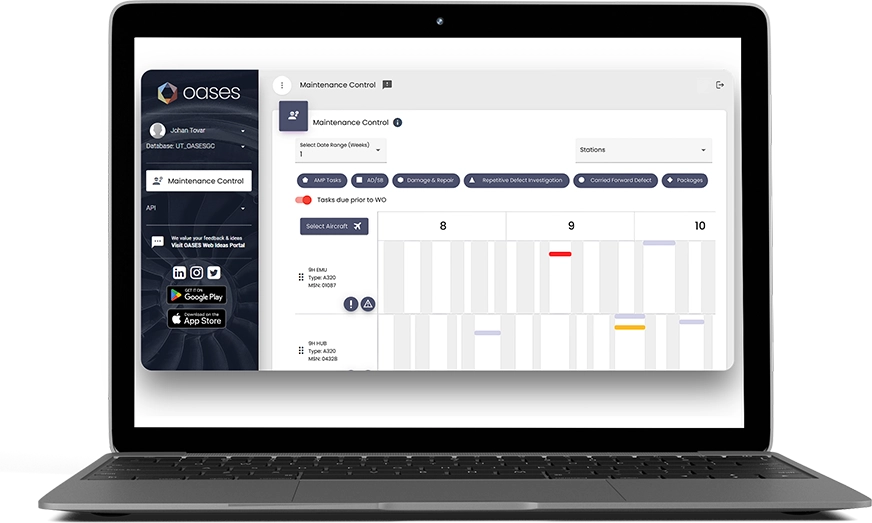Big Data can bring big problems as CAMOs and airline operators streamline their operations – Here’s how to make a smooth transition to the Cloud
by
Saidhar Pathigari, VP New Business at OASES

Let’s get critical
Do cloud providers rule the world? It depends on how you view what the world is, from a computing perspective. Quite simply, it’s a digital place—where automation of processes, AI and machine learning, anywhere and everywhere access to information and applications through any connected device—all come together to enable and empower organisations and their workers to work smarter.
In this blog, I outline who the industry front-runners in cloud services are, and then explore why you should be giving considerable attention to moving to the cloud. Then an overview of one of the biggest problems involved in cloud adoption—what to do with your data or, as some organisations ask, why do anything with it at all?
The benefits of a cloud implementation will be wide-ranging, and they will keep on coming, but only if the planning within your own operation has been detailed. Key to this is giving the highest priority to getting your data from wherever it is now, into where it will be for the future.
Why move to the cloud?
For some sectors, working smarter is focussed on improving sales and profitability. For others, it’s all about safety or tighter financial control. For others, the focus is primarily on reducing Total Cost of Ownership (TCO) of their technology assets. For CAMOs and airline operators in the aviation sector, ‘smarter’ is about all these essential requirements and more.
The world is moving to the cloud. Cloud providers are making this world possible. There is no shortage of choice in this market, although there is a very definite skew of market share towards the top three; Amazon Web Services (AWS), Microsoft Azure, and Google Cloud Platform (GCP). Of these, AWS holds the biggest share at around a third of the global market[1].
All these players are experts in one of the biggest areas that companies are often nervous about – cybersecurity. The hesitation that some companies used to have about not having their own data on their own premises has long dissipated. Best-in-class availability and redundancy are assured.
Common hindrances to total operational efficiency
- Lack of automation
Even in an industry as technology-driven as aviation, when it comes to on-the-ground services—and maintenance in particular—there remains an unusual preponderance of paper-based systems for numerous activities.
The scope of these approaches ranges from task scheduling, work order allocation, record keeping and maintenance control to material management, commercial management, and customs tracking.
Activities everywhere are fast-moving, highly detailed, hyper-critical, and stringently regulated. Also, for some, the management of the activities is much in need of streamlining.
- No single data source
When the information pertaining to all these activities is dispersed across the departments responsible for them, the ‘silo effect’ comes into play.
Although each function generating (and dependent on) information (data) is diligent in its processes, there is a lack of connection between information sources. The sources are certainly not automatically connected. There can be time lags in the transference of data, meaning it is not always as up-to-the-minute up-to-date as it could be; as it must be.
- Human error and resultant risk
Using spreadsheets and manually-generated records can also introduce two other complications which are simply untenable in any regulated environment; the possibility of human error, and the lack of certainty in the audit trail.
All these considerations compound risk. The silo effect makes things slower than they need to be, more costly and less reliable.
A cloud solution provides a step-change, enabling you to:
- Manage risk confidently
Be certain that the quality of your data is assured, and that any action is correctly informed by the right person having access to the right information, in the right place, at the right time. - Reduce costs
With one cloud-based repository, everything is current all the time, via any connected device. Evergreen, continuously deployed versions are delivered with no actions required.
There are no up-front costs, which results in a lower TCO than is incurred with maintaining an on-premise system with the need for hardware maintenance, or replacement, as it ages, and regular systems updating by your IT team or third-party IT service providers. There are also no worries about back-up, security, or availability.
- Trust your data
As you set off on your cloud journey, data will need to be moved from your present systems to your cloud infrastructure; from on-premise to, ultimately, on-somebody-else’s-premises—the datacentres of your chosen cloud platform services provider. While this is an exercise rich in opportunities, it is also highly challenging.
The overarching outcome will be that all your data, from all your systems, from back office to frontline operations, from engineers and maintenance crews, to finance, procurement, logistics and supply chain, will become accessible to all who need to use it. This will be your single view, your consistent and unified source, of the truth.
Data migration | Ensuring your smooth transition to the cloud
The team at OASES (Open Aviation Strategic Engineering System) helps customers in every part of the aviation industry to realise the benefits of digitising processes in MRO efficiency and logistics, compliance, safety, and financial management.
We are increasingly engaged with CAMOs and start-ups to help them move their data to the cloud. Many customers I work with have been delaying their transition to cloud due entirely to fears about how to handle their data.
I mentioned above that moving data across brings limitless opportunities, but also that it comes with challenges. It’s important to understand those challenges, because they are often buried deep in the data you already have.
Robust data migration starts with assessing the quality of your existing data.
This involves de-duplication, validation, and inspecting for anomalies and conflicts.
Its goal is to ensure that you don’t import problems into your new system.
This is a task for data specialists. It is also a task for skilled teams with engineering backgrounds in aviation. That is the profile of our team; people who know data and know what your requirements are, how your operations connect, what your workflows are, and what your regulation requirements are. Their role is to spot the gaps in your datasets so that process streamlining will start on Day 1 of cloud operations, not some time after all the teething issues have been sorted. We make the transition smooth. We do the heavy lifting. You take a big step into a digitised future.
OASES Cloud is hosted by AWS.
Manage the risk
Informed decisions, reduced costs, improved operational efficiencies, safety, and compliance all depend on one shared source of quality data. I’m always available to offer guidance on where the pitfalls might lie when moving data to the cloud; ready to help you identify the risks and quash them.
Just email me at: [email protected]
About Commsoft OASES
Commsoft’s OASES (Open Aviation Strategic Engineering System) is among the most successful aviation engineering and maintenance systems in the world with more than 130 aviation customers supported in some 55 countries across six continents. We understand aviation. Since 1975 we’ve accompanied and served the industry as its operations have evolved. We help national carriers, third party maintainers, regional carriers, leasing companies, cargo specialists, charter operators and rotary specialists based in the U.S., Europe, the Middle East, Asia, Africa and Australasia, in all areas of aviation maintenance support.




